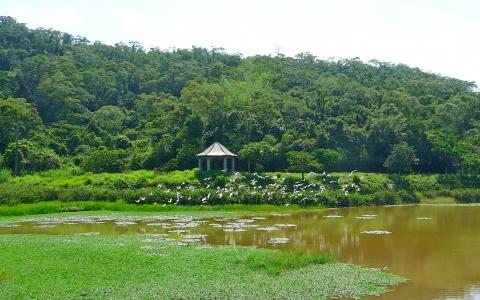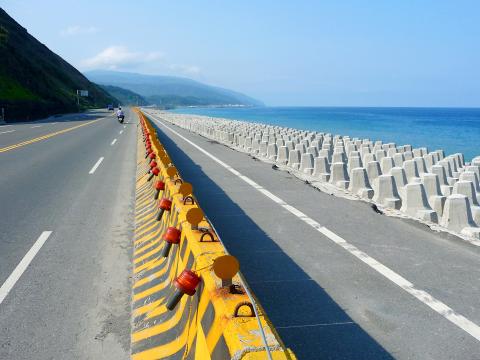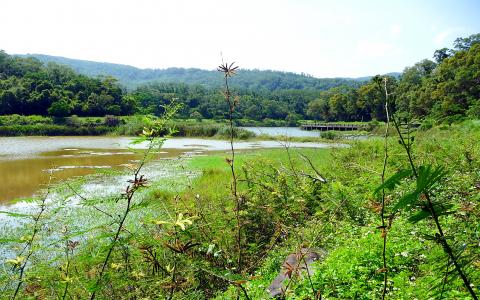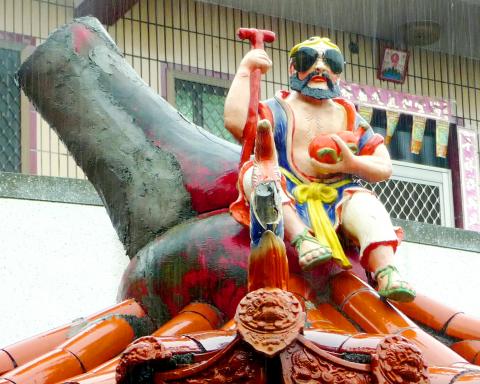Fewer than 6,000 people live in Taitung County’s Dawu Township (大武鄉). Like many places in the east, it has been losing inhabitants since the 1980s.
Dawu used to have two stations where passengers could alight from or board trains. Since October 2017, however, trains no longer stop at Gujhuang (古莊), and it has been downgraded to a signal station. There’s not much of a village here, and it seems the station never handled more than about a dozen rail travelers per week.
Yet what used to be Gujhuang Railway Station is currently a hive of activity, as I discovered on my most recent trip to the Dawu area. Taiwan Railways Administration is electrifying the South Link Line from Chaojhou (潮州) in Pingtung County to Taitung City, and Gujhuang is one of many sites where infrastructure is being installed.

Photo: Steven Crook
I was in Gujhuang because I wanted to ride my rental scooter along a couple of roads I’d noticed when poring over maps. The first leads north to a small lake that’s sometimes described as a tourist attraction.
The second points southwest away from the Pacific Ocean, then turns 90 degrees and returns to the coast roughly 7km from the busiest part of the township. I knew from experience that maps don’t always show every switchback — but from the several that were marked, I guessed I was in for a slow, twisting ride. Even so, I’m convinced that in rural Taitung there’s no such thing as an unenjoyable road.
JINLONG LAKE

Photo: Steven Crook
It took no time at all to reach Jinlong Lake (金龍湖), a spring-fed body of water on the inland side of a hill that looms over central Dawu. The water it stores helps nearby farmers get through dry spells. If it isn’t a world-class scenic spot, or even a top 20 sight in Taitung, it’s at least a fine place for a picnic. At the time of my visit, the lake was crowded with ducks and egrets who’d surely enjoy any crumbs you leave behind.
Returning to Gujhuang, I quickly found the other road that was piquing my curiosity. A few families live along the flatter northern stretch, which is called Taihu Road (太湖路). The route then becomes Shanjhuku (“Mountain Boar Cave”) Industrial Road (山豬窟產業道路), and it climbs to around 400m above sea level.
There were no houses along Shanjhuku Industrial Road, but I came across several types of economic activity. Turning a corner, I found a set of bee hives. Pausing at what I first thought to be a logging crew’s shelter, I realized that the trunks here were in fact being prepped for mushroom farming. Signs pointed down sideroads to tourist farms and campgrounds. But none of these distracted me from the magnificent views on either side of the road. I had protected mountain woodlands to my right, the Pacific to my left.

Photo: Steven Crook
When it was obvious I was on the downhill stretch, I turned off the engine and began to freewheel. I didn’t expect to see any wildlife while the sun was still high, so surprising a Swinhoe’s Pheasant on the road was a delightful bonus.
I didn’t encounter a single vehicle or person during the descent. In places Shanjhuku Industrial Road is a bit rough, and for much of its length it’s too narrow for two cars to pass.
About 10km from Gujhuang, the road rejoins Highway 9. Back on the main coastal route, I rode north to where Dawu’s coastal neighborhoods cluster on both sides of the river that shares the township’s name.

Photo: Steven Crook
DAWU OCEAN VIEW TRAIL
Dawu Ocean View Trail (大武觀海步道) has been thoroughly tidied up over the past year. There are two entrances to the trail, the northern one being more convenient if you park at the Forestry Bureau’s Dawu Ranger Station (大武工作站). According to the trail’s bilingual mapboards, the distance from that entrance to the southern gate (which is less than 200m from the ranger station) is precisely 1,000m, but you don’t need to go even half way if all you want is a fine view of the sea and the coastline to the south.
There was one more place I wanted to visit before riding north out of the township. Fu An Temple (福安宮) is at 110 Dawu Street (大武街), and I was curious to know if an unusual and certainly unofficial “artefact” was still there. As centers of Taiwan’s popular religion go, this shrine is neither large nor ornate. This isn’t surprising: It’s located in a region that’s mainly Christian and not especially prosperous.

Photo: Steven Crook
In fact, Fu An Temple looks like it’s seen much better days. When I came here last year, it was pouring with rain, and the roof was leaking. While waiting for the rain to ease off, I examined every part of the temple. Looking across the courtyard to the joss-paper furnace, I spotted a statuette of a man on top it. He was kneeling down. His pose and beard reminded me of those figurines, often on the external corners of temples, which are said to depict Westerners.
Only after gazing at it for several seconds did I realize why there was something vaguely rock-starry about this effigy. Someone — not me, because I don’t have that much imagination, and I’d never discard anything as useful as sunglasses — had gone to the trouble of clambering up and placing a pair of shades on the man’s face.
More than a year later, the sunglasses were still there. Was it possible that no one connected to the temple had noticed? Or had they seen them, decided they weren’t sacrilegious, and left them where they were? I live in a country where religious events often feature skimpily-dressed female pole dancers, so I’m not ruling anything out.
Steven Crook has been writing about travel, culture, and business in Taiwan since 1996. He is the co-author of A Culinary History of Taipei: Beyond Pork and Ponlai, and author of Taiwan: The Bradt Travel Guide, the third edition of which has just been published.

The canonical shot of an East Asian city is a night skyline studded with towering apartment and office buildings, bright with neon and plastic signage, a landscape of energy and modernity. Another classic image is the same city seen from above, in which identical apartment towers march across the city, spilling out over nearby geography, like stylized soldiers colonizing new territory in a board game. Densely populated dynamic conurbations of money, technological innovation and convenience, it is hard to see the cities of East Asia as what they truly are: necropolises. Why is this? The East Asian development model, with

June 16 to June 22 The following flyer appeared on the streets of Hsinchu on June 12, 1895: “Taipei has already fallen to the Japanese barbarians, who have brought great misery to our land and people. We heard that the Japanese occupiers will tax our gardens, our houses, our bodies, and even our chickens, dogs, cows and pigs. They wear their hair wild, carve their teeth, tattoo their foreheads, wear strange clothes and speak a strange language. How can we be ruled by such people?” Posted by civilian militia leader Wu Tang-hsing (吳湯興), it was a call to arms to retake

This is a deeply unsettling period in Taiwan. Uncertainties are everywhere while everyone waits for a small army of other shoes to drop on nearly every front. During challenging times, interesting political changes can happen, yet all three major political parties are beset with scandals, strife and self-inflicted wounds. As the ruling party, the Democratic Progressive Party (DPP) is held accountable for not only the challenges to the party, but also the nation. Taiwan is geopolitically and economically under threat. Domestically, the administration is under siege by the opposition-controlled legislature and growing discontent with what opponents characterize as arrogant, autocratic

When Lisa, 20, laces into her ultra-high heels for her shift at a strip club in Ukraine’s Kharkiv, she knows that aside from dancing, she will have to comfort traumatized soldiers. Since Russia’s 2022 invasion, exhausted troops are the main clientele of the Flash Dancers club in the center of the northeastern city, just 20 kilometers from Russian forces. For some customers, it provides an “escape” from the war, said Valerya Zavatska — a 25-year-old law graduate who runs the club with her mother, an ex-dancer. But many are not there just for the show. They “want to talk about what hurts,” she